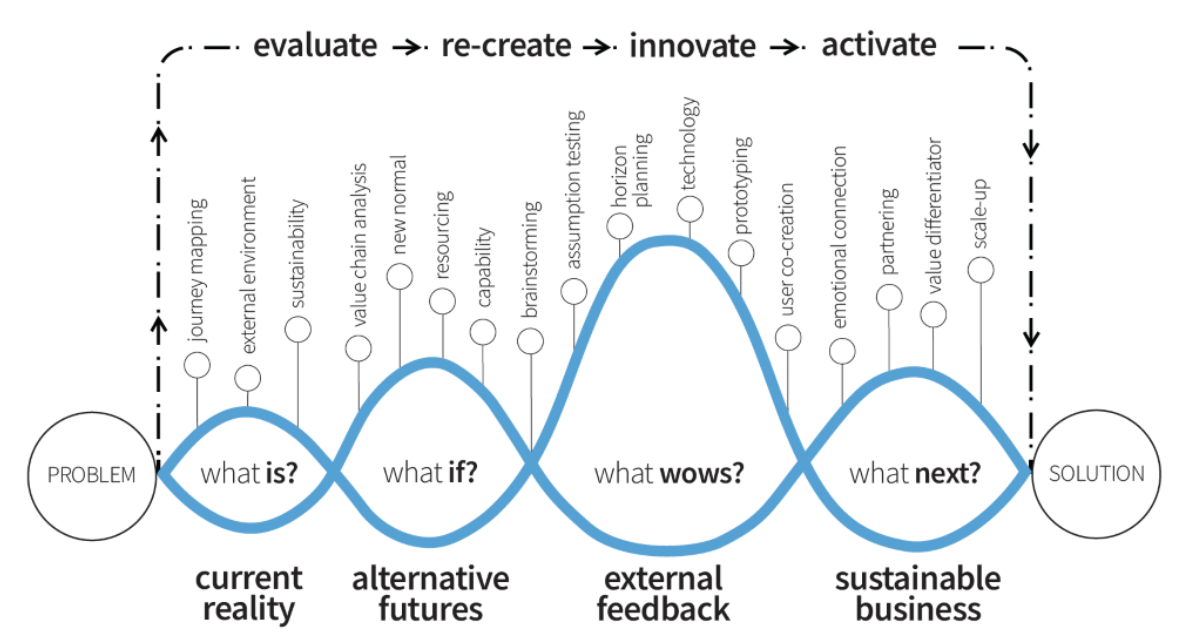It is becoming increasingly evident that the pace of change today is outstripping our ability to learn, with right now the recent environment of disruption, technology, automation and exponential change being labelled the next ‘Industrial Revolution’.
But don’t panic. Innovation is simply doing things differently in order to adapt to a changing environment. As a leader it should be part of your DNA to adapt, or as an emerging leader it is high on your list of capabilities to learn. It is not entirely new learning. Consider it as simply enabling a mindset of different seeing, thinking, planning and acting, every day. It is simply what next, at speed.
The challenge for businesses however is that as the pace of change is so rapid, the people led and (usually) technology driven response needs to be equally as rapid.
Traditional techniques and tools won’t accommodate this acceleration. The traditional concept of change management has adapted to more transformative models such as agile, amongst others.
And in saying that, even the concept of agile is being innovated further to that of ‘design thinking,’ a fast-tracked visualisation of user-experience and a continuum of testing, feedback and learning.
Innovation Is A Long Game.
Regardless of the current how for a minute, the concept of change remains as relevant now as ever, and the exponential difference required is an ability to introduce urgent response or innovation.
Beware the downside, or perhaps the innovation anxiety tipping the scales too far one way. There is so much change going on in some organisations that management often overlook evaluating the impact of the latest change before initiating the next, increasing the likelihood of workforce disengagement, productivity paralysis and failed innovation.
Innovation is a long game of continuous improvement. Don’t let it consume you to the point of going backwards, and eventually, of going nowhere.
Designing User Driven Data.
Traditionally we are inside-out thinkers meaning that we start with an issue as we see it and consider solutions within that paradigm. It focuses on internal processes, systems, tools, and products that designed based on internal bottom-line thinking. From a business point of view the shareholders needs and perspectives play a part in this type of thinking; a customer perspective is not always taken into consideration.
By contrast, outside-in thinking is the ability to view an issue from multiple perspectives, and least of all your own. This means that you look at your business from the customer or end-user perspective and subsequently design processes, tools, and products and make decisions based on what’s best for the customer and what meets this user’s needs.
From a business point of view having an open mind or an outside-in perspective enables us to anticipate and react to game-changing shifts.
In order to be an authentic outside-in thinker you may need to reassess your mindset and–
- Accept that you do not have all the angles covered,
- Encourage new insights from whoever can offer them,
- Tolerate well-intentioned failures. Fail fast, learn and move on.
Taking outside-in thinking to the next level is the relatively recent concept of ‘design thinking’ often described as a social technology or ethnography (a scientific description of people’s habits). People – and user driven data – being the ultimate enablers. It is customer viewpoint amplified 10x.
From the perspective of creating innovative strategies it is a sensing process that dilutes bias, it is a deeper understanding of a broader view of say, a user’s physical conditions, their business situation, the way they use and need a product for example, that builds a close connection with the user way beyond one dimensional google reviews and sales data.
A successful process must be experiential and is based predominantly on user-centric immersion, visualisation and innovation.
Design Thinking is not only a collaborative and iterative concept, it is a process that is a progressive experimental journey. It captures and creates uncontaminated visual assets along the way, the objective being to leverage human creativity and counteract human bias. By its very nature there can be numerous alternative versions of a design thinking process, however traditionally it hangs off 4 phases or iterations-
Phase 1 Customer Discovery
Recreate a meaningful user journey.
Phase 2 Creative Alignment
Specific solutions that inform design criteria.
Phase 3 Emergence
Prototyping far-from-complete products and ideas.
Phase 4 Learning In Action
Releasing innovation expecting further refinement.

And just a reminder that it is pointless simply jumping on board with this different way of thinking and doing without understanding (1) what you are changing, (2) why you are changing and (3) with whom are you changing it.
Getting Your Head in the Cloud.
Digital disruption is driving major changes in how businesses design and execute strategy. It is important that we understand that we are not necessarily creating new business with digital strategy (although some are!) however we are willingly embarking upon a strategy that will reinvent our business, our offering and our skills. It is fundamental change.
And bring it on. Not only does digitalisation provide an opportunity for us to ‘hang on’ (sometimes just by our fingernails!) to the current environment of business acceleration it also allows us to be at ground zero of this next ‘Industrial Revolution.’
For most of us, building and implementing digital strategy is unlikely to have been our core competency nor our fundamental revenue generator however now more than ever there is substantial evidence of technology implementation driving financial outperformance, particularly if you are prepared to be a first-mover or very-fast-first-follower.
Your digital strategy response quite simply is relative to the scale of reinvention your business needs, and how deep your pockets are. Are you all in, or are you a toe in the water kind of respondent? Are you a pioneer, a partner or a passenger?
As the pace of digital-related changes continues to accelerate, companies are required to make larger bets and to reallocate capital and people more quickly.
9 Perspectives That Will Assist Inform Your Digital Strategy:
- Jump On. Acknowledge and adapt to the digital-driven changes happening externally, as well as within your sector. Start small if you need.
- Integrate. Numerous digital ideas can be integrated as one strategy creating a dynamic framework for continuous business transformation.
- Tech Savvy. Businesses must educate their leaders on digital and encourage agile thinking that tests, learns and corrects quickly, rather than simply being compliant due to a lack of knowledge.
- No Pain, No Gain. Be prepared to fail fast, cut your losses and move on.
- Partnerships. Rather than pioneer a digital solution consider partnering with digital ecosystems providing the benefits of large-scale network effects.
- Innovation Cluster. Hedge your bets. A mix of digital adjustments to existing products bringing some revenue surety as well as brand-new digital offerings is a strategy often deployed by early adopters.
- Go Early. Don’t be afraid to invest in digital talent early. Technology is one thing however qualified digital talent is a scarce commodity, as the pace of digital still outstrips the supply of people who can deliver it.
- M&A. Consider a transaction to super-size the building of new digital capabilities.
- Re-Set Metrics. Redefine how you measure success and move away from old metrics that are no longer meaningful.
Augmented Human Talent
Technology is creating exponential data analyses that trigger predictive modelling, scenario management and unlocking decision-making.
The significance of this is that it has enabled another tech acronym in AH, or Augmented Humanity, the deployment of technology to enhance human capability.
Augmented talent is the human capability that can drive these technology outcomes. And taking it another step further, an augmented leader is one who has the capability to leverage technology in order to make fast, sophisticated, data-driven decisions that direct workers’ activities in partnership networks, not through chains of command.
However, there are limitations to this whole concept of augmented human talent whether it be the technology, or the enabler, the people. For now anyway.
AI and AH can enhance but will not replace human cognitive functions nor the emotional-social interaction. The hardest activities to automate with currently available technologies are those that involve managing and developing people or the expertise to make decisions around creative work.
Neither can AH replace (currently!) a leader’s creativity, strengths, aspirations, values or ability to make sense of experience. However, AI will augment those qualities and assist leaders leverage them to make decisions that optimise business outcomes.
There is no doubt that this future way of working will impact teams and the places within which they will co-exist, one that that will be comprised of employees, gig-workers and machines working side by side. The way teams interact virtually will affect organizational culture, its values and their alignment, however lessons can be learnt from the global enterprises that have been operating this way for some time. And for these organisations it is not virtual, it is reality.
Efforts to maintain relationships, effective two-way communication, critical thinking, co-operative decision-making, and developing competencies for example will need to be at a scale of which some have not yet experienced.
These cognitive human attributes are the qualities that will help leaders achieve success. The risk is that as technology gets better, cheaper, faster and more accessible, the things humans can do that machines can’t will only become more valuable.
Have you considered where you to need to develop your skills in order to stay in front of, or at least up with, this exponential curve?








